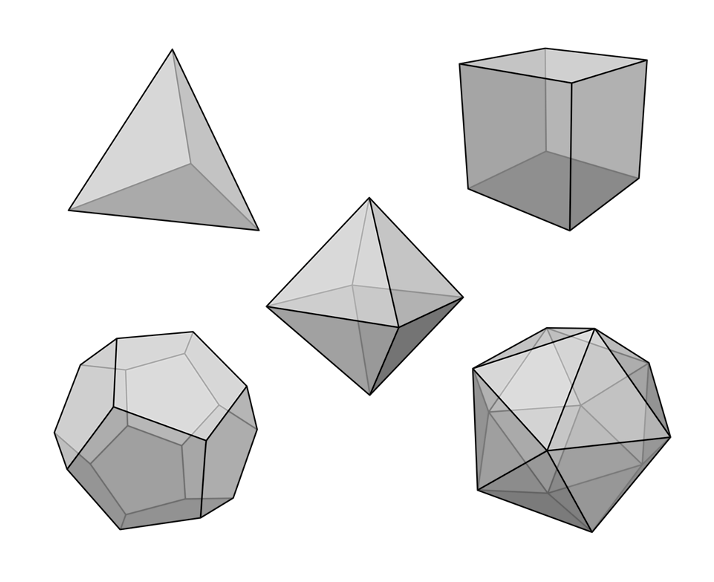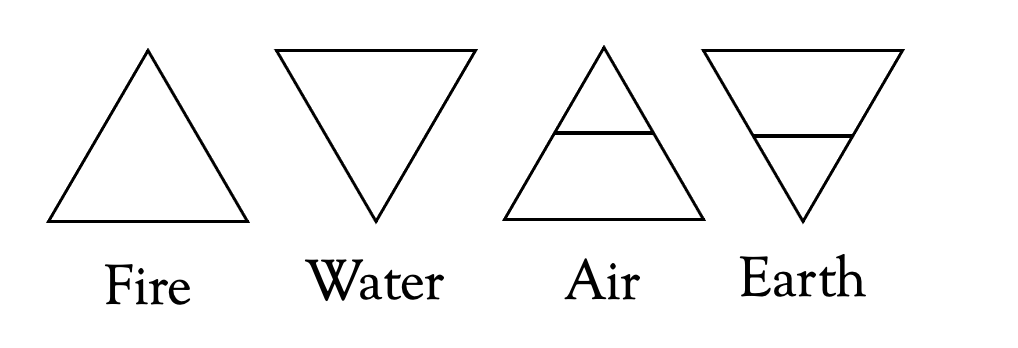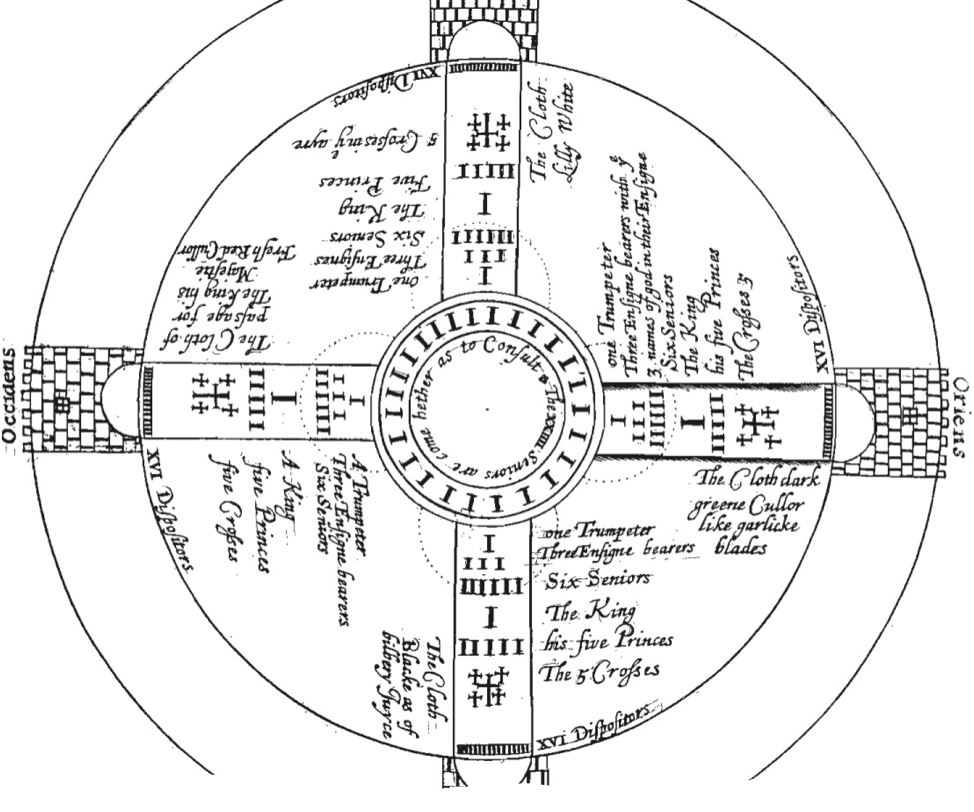Elemental History
The classical elements of earth, air, fire, and water have played a central role in the development of philosophy, science, mysticism, and religion for thousands of years. These four elements were believed to form the fundamental building blocks of the universe, shaping both physical matter and the metaphysical realms. Their influence spans from ancient Greek philosophy and alchemy to the esoteric traditions of the Hermetic Order of the Golden Dawn, the symbolism of the Tarot, and modern Wiccan practices. Traditionally, the elements also correspond to the masculine/feminine:
| Element | Correspondence |
|---|---|
| Fire | Masculine |
| Water | Feminine |
| Air | Masculine |
| Earth | Feminine |
Table 1. The masculine/feminine associations of the elements.
Ancient Greek Philosophy
The concept of the four classical elements originates with the pre-Socratic philosophers of ancient Greece, particularly Empedocles (circa 490-430 BCE), who first posited that the universe was composed of four fundamental substances: earth, air, fire, and water. According to Empedocles, these elements were eternal and unchanging, though they could combine and separate to form all the various objects and phenomena in the world. He introduced the idea that love (philia) and strife (neikos) were cosmic forces that influenced the interaction between the elements, shaping the natural world through harmony and discord.

Figure 1. Element properties of Dry, Wet, Hot, and Cold
An important classification of the elements during this period involved their associations with the qualities of hot, cold, dry, and wet. Aristotle related each of the four elements to two of the four sensible qualities:
Fire: is primarily hot and secondarily dry. Air: is primarily wet and secondarily hot. Water: is primarily cold and secondarily wet. Earth: is primarily dry and secondarily cold.
These qualities allowed the elements to be understood in terms of their dynamic interactions, leading to the formation of more complex phenomena by balancing their opposing or complementary forces. This idea of elemental balance would influence not just philosophy but medicine and the arts for centuries to come. Ancient philosophers also equated the elements, further still, to the following properties:
| Element | |||
|---|---|---|---|
| Fire | Sharp | Subtle | Mobile |
| Air | Blunt | Subtle | Mobile |
| Water | Blunt | Dense | Mobile |
| Earth | Blunt | Dense | Immobile |
Table 2. Elemental Properties
Plato further developed this theory in his dialogue Timaeus (circa 360 BCE), associating the elements with specific geometrical shapes known as Platonic solids. Fire was linked to the tetrahedron, air to the octahedron, water to the icosahedron, and earth to the cube. Plato’s work influenced his student Aristotle, who expanded on the concept by adding a fifth element in Physics (circa 350 BCS), 'aether' or 'quintessence', believed to be the material of the heavens governing the stars and planets. Aristotle's classification of the elements became deeply embedded in Western thought for centuries.

Figure 2. The Platonic Solids
| Element | Solid | Faces (sides) | Shape | Edges | Points |
|---|---|---|---|---|---|
| Fire | Tetrahedron | 4 | Equilateral Triangle | 6 | 4 |
| Water | Icosahedron | 20 | Equilateral Triangle | 30 | 12 |
| Air | Octahedron | 8 | Equilateral Triangle | 12 | 6 |
| Earth | Hexahedron (cube) | 6 | Regular Square | 12 | 8 |
| Quintessence | Dodecahedron | 12 | Pentagon | 30 | 20 |
Table 3. The Platonic Solids' Properties
Alchemical Usage
The classical elements became central to the practice of alchemy during the Middle Ages, a mystical proto-science that sought to understand the nature of matter and transmute base metals into gold. Alchemists saw the elements not only as physical substances but also as symbolic representations of spiritual principles. The Latin names more associated with Alchemy are Aqua (water), Ignis (Fire) and Aer (Air) and Terra (earth).
In alchemy, the elements correspond to various processes, materials, creatures, and states of being. Earth represented stability, physicality, and the body. Air symbolised the intellect, thought, and communication. Fire was linked to transformation, energy, and passion. Water was associated with emotion, intuition, and purification. These elemental principles were integrated into the alchemical phases of transformation, such as nigredo (blackening), albedo (whitening), citrinitas (yellowing or peacock's tail), and rubedo (reddening).
Alchemical texts often depicted the elements in diagrams and symbols, and practitioners aimed to balance these forces within themselves and their materials to achieve both spiritual enlightenment and material success. The transmutation of lead into gold was a metaphor for the transformation of the alchemist’s soul, refining and elevating it through the balance of the elements.
The Alchemical Symbols of the Elements
The alchemical symbols became standardised in Western alchemy during the medieval and Renaissance periods. Though the idea of the four elements originated with ancient Greek philosophers, the actual symbols associated with these elements emerged much later in esoteric and alchemical texts. The symbols were used to communicate the nature of the elements not only in terms of physical matter but also their metaphysical roles in the process of transformation. The masculine elements are those of Fire and Air and are represented by forms of upwards pointing triangles, connoting the active force and symbolising the phallus. Water and Earth are the feminine elements, with their symbols being forms of downward pointing triangles. This is the passive and also represents the womb. The masculine elements also point upwards as their physical form rise towards the Starry Heavens, whereas the feminine ones fall down to Earth.
The Elemental Symbols
The earliest known drawings and descriptions of the elemental symbols can be traced to alchemical texts from the late Middle Ages, particularly around the 15th century. These symbols appear in manuscripts such as 'Rosarium Philosophorum' (1550), which features diagrams and treatises that explore the symbolism of the elements, transformation, and the nature of matter. The Rosarium, widely regarded as a central alchemical work, contains imagery that shows the elemental triangles and their use in alchemical processes.

Figure 3. The alchemical elemental symbols.
The symbols representing the elements are geometric and simple, designed to convey both the directional qualities (up for fire and gravity pulling down water) and the foundational role of each element in alchemy. The direction of the triangle is associated to whether they are masculine/feminine and are represented by the upwards-pointed triangle (phallus) or downwards triangle (womb).
In alchemical symbolism, fire and water are considered major elements due to their primal, uncontained nature, and their symbols are simple triangles with no additional markings. On the other hand, earth and air are regarded as the lesser elements, and their symbols contain a horizontal line across the triangle.
These symbols appear in manuscripts such as Heinrich Cornelius Agrippa’s 'De Occulta Philosophia' (1533), which provided a detailed study of the natural world, elements, and their properties. Agrippa’s work was influential in linking the classical elements with esoteric practices, and he popularized the use of these symbols in magical and alchemical contexts.
John Dee and the Watchtowers

Figure 4. John Dee's watchtower vision diagram (museum of witchcraft)
John Dee, the 16th-century English mathematician, astronomer, and occultist, introduced the concept of the Watchtowers into Western esotericism. Dee and his associate, Edward Kelley, developed a system of angelic magic known as Enochian magic, in which the Watchtowers played a key role. These Watchtowers were described as four elemental 'towers' that guarded the corners of the universe and were linked to the four classical elements: earth, air, fire, and water.
Each Watchtower was said to represent a direction (north, east, south, west) and corresponded to one of the elements, much like the Golden Dawn’s elemental system. Dee’s concept emphasized the spiritual forces behind the elements, suggesting that they were governed by powerful angelic entities. The Watchtowers would later influence ceremonial magic and be integrated into the practices of groups like the Hermetic Order of the Golden Dawn.
Introduction into the Hermetic Order of the Golden Dawn
The Hermetic Order of the Golden Dawn, a late 19th-century esoteric society, drew heavily from ancient traditions, including alchemy, Qabala, and Hermeticism. The four classical elements played a vital role in the Golden Dawn’s rituals and teachings, representing both material forces and spiritual states of being.
In the Golden Dawn system, the elements were associated with specific tools, colours, and directions within ritual magic. Earth was linked to the pentacle, the north, and the colour green. Air corresponded to the dagger, the east, and yellow. Fire was connected to the wand, the south, and red. Water was associated with the cup, the west, and blue. These associations were used in rituals to invoke elemental forces for the purpose of self-transformation and magical work.
The Golden Dawn's elemental symbolism significantly influenced later occult practices, including the development of modern ceremonial magic and the broader Western esoteric tradition. The Order emphasised the importance of mastering the elements as part of the initiate’s spiritual journey, seeing them as gateways to higher knowledge and power.
The Elements and the Zodiac Signs
In astrology, the classical elements are deeply tied to the twelve zodiac signs. Each element rules over three zodiac signs, forming the four triplicities, which reflect the fundamental qualities of each element in an astrological context:
- Earth: Taurus, Virgo, and Capricorn.
- Air: Gemini, Libra, and Aquarius.
- Fire: Aries, Leo, and Sagittarius.
- Water: Cancer, Scorpio, and Pisces.
These elemental groupings shape the personality traits and behaviours attributed with each sign. For example, fire signs are often seen as bold and dynamic, while water signs are regarded as emotional and sensitive. Some believe that the interplay of these elemental forces in a person’s astrological chart is thought to determine their strengths, challenges, and overall character.
Within the Tarot and ceremonial magick, the fixed signs (Aries, Taurus, Gemini, Cancer), in particular, are often associated with the elements. For example, their representations are found within the four corners of the world card.
Their use within the Tarot
The classical elements also play a crucial role in the Tarot, a divinatory tool with roots in Renaissance Europe that was later adapted by occultists in the 19th century. In Tarot, the four elements are represented by the four suits of the Minor Arcana, each reflecting different aspects of human experience.
- Earth is symbolized by the suit of Pentacles (or Coins), representing material wealth, physical health, and the practical aspects of life.
- Air is reflected in the suit of Swords, associated with intellect, communication, and decision-making.
- Fire is embodied by the suit of Wands (or Staves), signifying creativity, ambition, and transformation.
- Water is represented by the suit of Cups, linked to emotions, relationships, and intuition.
Adoption into Wicca
In the 20th century, the classical elements were adopted into the modern pagan religion of Wicca, which draws from a variety of sources including ancient paganism, Western occultism, and the teachings of the Hermetic Order of the Golden Dawn. In Wicca, the elements are seen as fundamental forces of nature, each representing a different aspect of life and the cosmos.
Wiccans often work with the elements in ritual and magic, invoking them to create sacred space and align with natural forces. Each element is associated with a cardinal direction and is called upon during the casting of a magic circle, a central component of Wiccan practice:
- Earth (North)
- Air (East)
- Fire (South)
- Water (West)
Conclusion
The classical elements of earth, air, fire, and water have shaped human understanding of the world for millennia. From the ancient Greeks to modern Wiccans, these elements have been used to explain the workings of the universe, symbolise spiritual principles, and serve as powerful tools for transformation. Whether in philosophy, alchemy, astrology, the Tarot, or divination, the elements remain an enduring and essential part of the Western esoteric tradition.